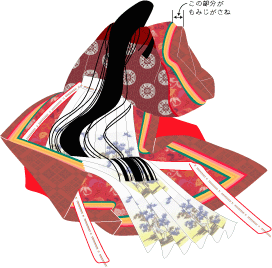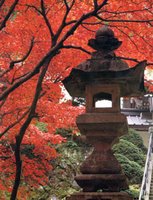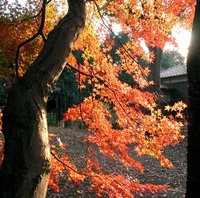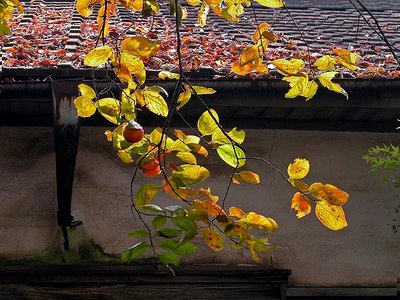:::::::::::::::::::::::::::::::::::::::::::::::::::::::::::::::::::::::::::::::::::::::::::::::::::::
Red autumn leaves, red leaves (momiji)
***** Location: Japan, other countries
***** Season: Late Autumn
***** Category: Plant/Humanity/Obeservances
*****************************
Explanation
A word of caution:
The words LEAF, LEAVES, BLATT, BLÄTTER ...
are NOT kigo, but topics for haiku.
Many trees have leaves in all seasons.
. Leaves in all seasons .
:::::::::::::::::::::::::::::::::::::::::::::::::::::::::::::::::::::::::::::::::::::::::::::::::::::

Koshihata Village, Okayama
The red leaves, colored leaves, momiji (kooyoo 紅葉) ,
are usually the subject of "hunting for them".
Yellow leaves are of course also part of the momiji kigo 紅葉
Red maple leaf, red maple leaves.
Red autumn colors, and other translations are possible.
The word maple leaf (kaede no ha カエデの葉) is not a kigo.
By changing the Chinese characters, we can distinguish between
紅葉 red autumn leaves
黄葉 yellow autum leaves
momiizuru もみいづる red autumn leaves
... momizuru もみづる
.................................................................................
na no ki momiji 名木紅葉(なのきのもみじ)
red autum leaves from special trees
urushi momiji 漆紅葉(うるしもみじ)momiji of the laquer tree
..... nurude momiji 白膠紅葉(ぬるでもみじ)
haze momiji 櫨紅葉(はぜもみじ)momiji of the wax tree
ichoo momiji 銀杏黄葉(いちょうもみじ)momiji of the gingko tree
kashiwa mojimi 柏黄葉(かしわもみじ)momiji of the Kashiwa oak
kaki momiji 柿紅葉(かきもみじ)momiji of the persimmon tree
ume momiji 梅紅葉(うめもみじ)momiji of the plum tree
nemu momiji 合歓紅葉(ねむもみじ)momiji of the mimosa tree
toodan momiji 満天星紅葉(どうだんもみじ)
momiji of Enkianthus perulatus
budoo momiji 葡萄紅葉(ぶどうもみじ)momiji of grapes
shirakaba momiji 白樺黄葉(しらかばもみじ)momiji of the birch tree
zooki momiji 雑木紅葉(ぞうきもみじ)momiji of miscellaneous small trees
teriha 照葉(てりは) "shining leaves"
yuumomiji 夕紅葉(ゆうもみじ)momiji in the evening
mura momiji むら紅葉(むらもみじ)momiji in the village
shita momiji, shitamomiji 下紅葉(したもみじ) lit."lower momiji"
refers to the lower red leaves of a tree or the red leaves covering the ground
tani momiji 谿紅葉(たにもみじ)momiji in the valley
niwa mojimi 庭紅葉(にわもみじ)momiji in the garden
momijigawa 紅葉川(もみじがわ)river with momiji
momijiyama 紅葉山(もみじやま)mountain with momiji
momiji no fuchi 紅葉の淵(もみじのふち)river edge with momiji
momiji no kasa 紅葉の笠(もみじのかさ)
Tatsutagusa 龍田草(たつたぐさ)momiji of Tatsuta
. 竜田姫, Princess Tatsuta of Autumn .
iromigusa 色見草(いろみぐさ)momiji of kaede mapel
tsumagoigusa 妻恋草(つまこいぐさ)
"plant to make me love my wife"
.................................................................................
"hunting for red leaves" momijigari
紅葉狩 (もみじがり)
going out to enjoy a picnick and the colored leaves of autumn. The famous temples of Kyoto and in other area were especially crowded during this season.
.... momiji mi 紅葉見(もみじみ)
..... kanpuu 観楓(かんぷう)
stepping on red leaves, momiji fumu 紅葉踏む(もみじふむ)
rice wine drunk whilst watching red leaves,
momijizake紅葉酒(もみじざけ)
tea house from where to watch red leaves, momiji chaya
紅葉茶屋(もみじぢゃや)
ship from which to enjoy red leaves, momijibune
紅葉舟(もみじぶね)
bonfire with red leaves, momiji taku 紅葉焚く(もみじたく)
enjoying the season of red leaves at the Imperial Palace
momiji no ga 紅葉の賀 もみじのが
watching red leaves at the Imperial Palace,
..... aki no gyoyuu 秋の御遊(あきのぎょゆう)
.................................................................................
kigo for mid-autumn
. leaf month, hazuki 葉月 (はづき) .
(the 8th month in the Asian lunar calendar, now September)
. hazukijio 葉月潮(はづきじお)tide of the eighth lunar month .
hatsu mojiji 初紅葉 (はつもみじ) first red autumn leaves
usumomiji, usu mojiji 薄紅葉 (うすもみじ ) "thin red autumn leaves"
(just beginning to take on color)
.................................................................................
kigo for early autumn
. "bridge of red leaves" momiji no hashi
紅葉の橋(もみじのはし) .
another name for the two stars of the Tanabata Star Festival.

momiji no tobari 紅葉の帳(もみじのとばり) "balance book in red" like the autumn leaves.
During the rituals at the Imperial court, whith the music of koto and other instruments.
(for the Tanabata Star Festival)
. kaji no ha 梶の葉 (かじのは ) paper mulberry leaf .
to write poetry for the Tanabata Star Festival
.................................................................................
kigo for late autumn
. momijizuki 紅葉月(もみはづき)month with red leaves .
(the 9th month in the Asian lunar calendar, now October)
nishikigi 錦木 (にしきぎ) momiji of the winged spindle-tree
Euonymus alatus
..... nishikigi no mi 錦木の実 fruit of the winged spindle-tree
kooyoo 黄葉 こうよう yellow autumn leaves
momiji もみじ、momijiba もみじば
momiji suru kusaki 黄葉する草木(もみじするくさき)
trees and plants with yellow autumn leaves
momiji katsu chiru 紅葉かつ散る (もみじかつちる)
red leaves falling
iroha chiru 色葉散る(いろはちる)colored leaves are falling
iro nagara chiru 色ながら散る(いろながらちる)
"still colorful but falling"
konoha katsu chiru 木の葉かつ散る(このはかつちる)
leaves of trees are falling
kooraku 黄落 (こうらく) "yellow is falling"
kooraku ki 黄落期(こうらくき)
time of yellow (and red) leaves falling
hahaso momiji 柞紅葉 Japanese Emperor Oak momiji
Quercus dentata
nara momiji 楢紅葉(ならもみじ) Quercus serrata
. Kaede 楓 Maple Tree .
and maple syrup
kaede and momiji vocabulary :
Ao momiji (green maples)
Haji momiji (sumac maples)
Kaede momiji (downy maples)
Kurenai momiji (pink maples)
Moriji momiji (mixed maples)
Momiji no samazama (diverse maples)
Ki momiji (yellow maples)
:::::::::::::::::::::::::::::::::::::::::::::::::::::::::::::::::::::::::::::::::::::::::::::::::::::

special robe for watching red leaves, momiji goromo
紅葉衣 (もみじごろも)
..... momiji gasane 紅葉重(もみじがさね)

:::::::::::::::::::::::::::::::::::::::::::::::::::::::::::::::::::::::::::::::::::::::::::::::::::::
Please read the entry about the human activities for further explanation.
Leaf Watching, leaf peeping Momijigari
:::::::::::::::::::::::::::::::::::::::::::::::::::::::::::::::::::::::::::::::::::::::::::::::::::::
bitterling, broad-striped, green-striped
momiji tanago 紅葉たなご (もみじたなご)
"bitterling like red leaves"
reddened carp, momijibuna, momiji-buna
紅葉鮒 (もみじぶな)
Literally: Carp like red leaves.
landlocked salmon "among the leaves", konoha yamame
木の葉山女
a kind of trout.
. Fish in Autumn .
:::::::::::::::::::::::::::::::::::::::::::::::::::::::::::::::::::::::::::::::::::::::::::::::::::::
kigo for winter
red leaves in winter, fuyu momiji
冬紅葉 (ふゆもみじ)
red leaves still left over, nokoru momiji 残る紅葉(のこるもみじ)
red leaves scattering, momiji chiru
紅葉散る (もみじちる)
..... chiri momiji 散紅葉(ちりもみじ)
:::::::::::::::::::::::::::::::::::::::::::::::::::::::::::::::::::::::::::::::::::::::::::::::::::::
Memorial Day of Osaki Koyo
(Oosaki Kooyoo 尾崎 紅葉(おざき こうよう)
Kooyoo ki 紅葉忌 (こうようき ) "Red leaves memorial day"
Tochiman Doo Ki 十千万堂忌(とちまんどうき)
Koyo was a novelist, his most famous novel was Tochiman Doo.
慶応3年12月16日(1868年1月10日) - 明治36年(1903年)10月30日)
Osaki Koyo (1867–1903)
blazing sun —
whose barefoot child
is running free
Cayır cayır güneş—
Kimin yalınayak çocuğu
ki böyle koşar.
Under the night moon,
playing the flute quite badly—
my neighbor—listen.
Gece mehtapta
Flütü çok kötü çalar—
Komşum— Dinle bak!
© Çeviri: Turgay Uçeren
:::::::::::::::::::::::::::::::::::::::::::::::::::::::::::::::::::::::::::::::::::::::::::::::::::::
Now I will add some more pictures and haiku.
At the temple Daiyuu-zan 大雄山 in Kanagawa Pref.

http://www.daiyuuzan.or.jp/
xxxxxxxxxxxxxxxxxxxxxxxxxxxxx
Japanese Haiku and Photos, Toori Gallery

紅葉狩まずは田楽食べてをり
http://www.interone.jp/~touri/garo/garo.htm
xxxxxxxxxxxxxxxxxxxxxxxxxxxxx
A carpet of colored leaves.

Yamashina, Bishamon-Doo, Kyoto.
Look at a lot more autumn pictures.
http://www.eonet.ne.jp/~kikusui/sub18.htm
*****************************
Worldwide use
USA
Fall color frames Attic Window peak on Grandfather Mountain near Linville, N.C., Saturday, Sept. 25, 2004 fro just below the Blue Ridge Parkway Viaduct. Despite flooding from Hurricanes Ivan and France, all sections of the Blue Ridge Parkway north of Linville Falls are now open as the fall viewing season begins. (AP Photo/Grandfather Mountain, Hugh Morton)
http://news.yahoo.com/news?tmpl=story&u=/040925/480/nccb20109251957
*****************************
Things found on the way
momiji nu, momijinu もみじ ぬ
the absence of autumn colors
This has also been the subject of poetry since olden times.
樫の葉の もみじ ぬからにちりつもる
奥山寺のさびしさよ
Leaves of oak trees
fallen before they become
red and yellow.
Loneliness of a temple
faraway in the mountain
source : rakushin sha
There is also a positive verb
momizu もみず【紅葉づ/黄葉づ】
to become red and yellow with autumn leaves
:::::::::::::::::::::::::::::::::::::::::::::::::::::::::::::::::::::::::::::::::::::::::::::::::::::

food plate called
ship from which to enjoy red leaves, momijibune
紅葉舟(もみじぶね)
:::::::::::::::::::::::::::::::::::::::::::::::::::::::::::::::::::::::::::::::::::::::::::::::::::::
:::::::::::::::::::::::::::::::::::::::::::::::::::::::::::::::::::::::::::::::::::::::::::::::::::::::::::::::::::::::::::
senryu from Edo 江戸の川柳
紅葉狩り例年行けどいまだ見ず
momijigari reinen ikedo imada mizu
viewing the red maple leaves
they go for it every year
but have not seen them yet
This refers to the menfolk of Edo.
There were two famous momiji spots, but one was close to the pleasure quarters of Yoshiwara 吉原 and the other further down, also near the cheaper pleasure quarters.
So . . . when the menfolk took off with the excuse of enjoying the red autumn leaves, . . .
. senryu, senryū 川柳 Senryu in Edo .
:::::::::::::::::::::::::::::::::::::::::::::::::::::::::::::::::::::::::::::::::::::::::::::::::::::::::::::::::::::::::::
. Momiji Daruma .
:::::::::::::::::::::::::::::::::::::::::::::::::::::::::::::::::::::::::::::::::::::::::::::::::::::
. momiji manjuu もみじ饅頭 bean paste buns.
from Miyajima, Hiroshima
Manju in der Form von Ahornbälttern
. Momiji tenpura 紅葉の天ぷら tempura from maple leaves .
*****************************
HAIKU
Japanese Haiku and Photos, Toori Gallery
紅葉狩まずは田楽食べてをり... 雛菊
紅葉
http://www.interone.jp/~touri/garo/garo.htm
武蔵野や桜紅葉に夜の雨
ぽぽな
Musashino Plain -
red leaves of cherries
in evening rain
どうしたらいいのか紅葉ちりやまず
雪女
what best to do?
the red leaves
keep falling

http://www.interone.jp/~touri/garo/image/yurikaki.jpg
. WKD : Musashino Plain 武蔵野 .
:::::::::::::::::::::::::::::::::::::::::::::::::::::::::::::::::::::::::::::::::::::::::::::::::::::
Zen garden -
goldfish and maple leaves
the same deep red
Andre Surridge, 2006 NZ
xxxxxxxxxxxxxxxxxxxxxxxxxxxxx
autumn -
leaves with patterns
to wonder and ponder
Look at my leaf collection here !
Gabi Greve, Autumn 2006
:::::::::::::::::::::::::::::::::::::::::::::::::::::::::::::::::::::::::::::::::::::::::::::::::::::
*****************************
Related words
***** Leaf Watching momijigari 紅葉狩り
***** Fallen leaves (ochiba) 落ち葉
***** Colored cover leaves of beech tree buds falling on snow
yuki momiji 雪もみじ , haru momiji 春もみじ
kigo for early spring
This is a phenomenon of the beech tree woods in Northern Japan. The small red leaves, which cover the buds of the beech trees during winter, fall on the snow when it gets warmer and the tree gets ready to produce new leaves. This might be as late as May.

月山周辺の豊かな自然を紹介します。
五月の風物詩・まさに東北の原風景とも言える「春もみじ」と「雪もみじ」と「根開き」の三点セットが園内にでそろいました。
http://blog.yahoo.co.jp/gassan_bunarin/3139817.html
:::::::::::::::::::::::::::::::::::::::::::::::::::::::::::::::::::::::::::::::::::::::::::::::::::::
. Fallen leaves (ochiba 落葉)
. Leaves in all seasons .
[ . BACK to WORLDKIGO . TOP . ]
:::::::::::::::::::::::::::::::::::::::::::::::::::::::::::::::::::::::::::::::::::::::::::::::::::::








7 comments:
late autumn sun -
the shadows of leaves
on leaves
autumn leaves -
a last ray of sunshine
in the woods
Click on the haiku to see them !
Gabi Greve, November 2006
::::::::::::::::::::::::::::::::::::::::::::::::::::::::::::::::::::::::::
.
Maple Syrup North America
.
Sumac / Wikipedia
Rhus is a genus of approximately 250 species of flowering plants in the family Anacardiaceae. They are commonly called sumac or sumach.
Some species (including Poison ivy, poison-oak, and poison sumac), often placed in this genus, are here treated in the genus Toxicodendron, which differs in highly allergenic foliage and grayish-white fruit but is not genetically distinct. The name derives from the Greek name for sumac, rhous.
The leaves are spirally arranged; they are usually pinnately compound, though some species have trifoliate or simple leaves.
LOOK at some colored leaves !
..................................
Japanese Maples, Kaede and Momiji
Horizontal distribution and vertical distribution
It is generally said that horizontal distribution is the distribution of the vegetation corresponding to climatic zones, such as arctic zone, temperate zone and tropical zone, which are owing to the climatic conditions, such as temperature and precipitation, and the vegetation contains the needle-leaved trees, deciduous broad-leaved trees, ever-green broad-leaved trees, etc. The difference of such conditions are also contained as high humidity when hot in Japan, and as high humidity when cold in Europe.
And is said that vertical distribution is the distribution of vegetation according to the height above sea level. The conditions of vertical distribution change owing to latitudinal difference. This generally means that what are at high places in the south are at lower places in the north, but the conditions of distribution are influenced by the accumulated temperatures and the underground moisture content except the average values of temperature and humidity.
"In the region of the Himalayas, the upper limit of a rice crop is about 1800m, and that of bananas is about 2000m in Nepal and its neighborhood. Even in cold places where a rice crop cannot be grown, bananas can be cultivated. On the south side of the Himalayas it's warm in winter and fairly cool in summer similar to the character of an alpine climate in the tropics. As rice is the summer crop, the upper limit of rice is determined by the accumulated temperature in summer, on the other hand, that of bananas is determined by the coldness in winter. It is a strange phenomenon that bananas can be cultivated up in higher places."
(quoted from "Shohyohjurin Bunka" by Nakao Sasuke, Ueyama Shumpei; my translation)
Physiographic factors and climatic factors also have influence on maple distribution.
Let me show a few here.
Maples having the characteristic distribution
1. Iroha-momiji (Acer palmatum) & Yama-momiji (Acer matsumurae)
Iroha-momiji, yama-momiji and o-momiji (Acer amoenum) can be regarded as the same family. Iroha-momiji are distributed along the Pacific coast (except Hokkaido & the northern Honshu), and yama-momiji along the Japan Sea coast (from Aomori to Fukui Prefecture). (based on the document No.3 by Prof.Ogata )
It seems possible for us to discriminate roughly among 3 species with the addition of o-momiji. But now as there are many kinds of cultivars in addition to these 3 natural species, it might be fairly difficult for us to distinguish accurately by the shape of a leaf when asked what kind it belongs to. They all are generally called "momiji."
2. Hananoki (Acer pycnanthum)
This maple is loved as the Tree of Aichi Prefecture. The distribution of the natural Hananoki is limited to Aichi,Gifu and Nagano Prefecture, and the Kiso basin. Some has been designated as natural monuments. I've been to Anan (Nagano), Sakamoto (Gifu) and Yukiyoshi Shrine (Aichi). Their pictures are on this homepage at the item "Autumn color mechanism" and in the "list of Japanese maples." The Hananokis at Kita-hanazawa and Minami-hanazawa (Shiga) are said to be transplanted, and there seems to be a tradition that Shotoku-Taishi himself planted them. (from document No.1)
3. Kusunoha-kaede (Acer oblongum)
This species is from Ryukyu (Okinawa Prefecture), as well as Taiwan and Himalayas. The shape of the leaves is like that of camphor's leaves, which are non-lobed. This is the only maple whose leaves are ever-green in Japan (from document No.15).
4. Kurobi-itaya (Acer miyabei)
I hear this is similar to Itaya-kaede (Acer mono), and is rarely seen in Hokkaido and Tohoku District. I've seen this maple at the Nikko Botanical Garden, and I would like to meet this species at the place where they originate.
Vertical distribution of Chubu District (mainly concerning Shizuoka Prefecture)
... Subalpine zone above 1600m : Mine-kaede and Ogarabana
Mine-kaede (Acer tschonoskii) could be seen at the Mugikusa Pass (2127m), the Shirabiso Highlands (1833m), Mt. Mizugaki, etc., Ogarabana (Acer ukurunduense) at halfway up Mt. Yakushidake, the Yachiho Highlands, halfway up Mt.Mizugaki and in the Shirabiso Highlands.
... Above 1300m :
Tetsu-kaede (Acer nipponicum) at halfway up Mt.Yakushidake and on the way from the Yashajin Pass to Hirogawara
... Below 1000m :
Hananoki (Acer pycnanthum), Iroha-momiji (Acer palmatum), Toh-kaede (Acer buergerianum), Uri-kaede (Acer crataegifolium), Yama-momiji (Acer matsumurae, in Fukui Prefecture)
... From 1000m to 1300m :
Many species in addition to those mentioned above are distributed from1000m to 1300m. In Shizuoka Prefecture we can arrive at these places by a 2 hour drive from the Pacific Coast, such as Mt. Chausu, the Hyogoshi Pass, the Aokuzure Pass, Ikawa, Sumata Ravine, Umegashima, Mt. Minobu, Mt. Fuji and the Izu Amagi Pass. We can see the following species at these places.
O-momiji (Acer amoenum), Hauchiwa-kaede (Acer japonicum), Ko-hauchiwa-kaede (Acer sieboldianum), Hina-uchiwa-kaede (Acer tenuifolium), O-itaya-meigetsu (Acer shirasawanum), Urihada-kaede (Acer rufinerve), Hosoe-kaede (Acer capillipes), Itaya-kaede (Acer mono), Hitotsuba-kaede (Acer distylum), Chidorinoki (Acer carpinifolium), Mitsude-kaede (Acer cissifolium), Megusurinoki (Acer nikoense),
Karakogi-kaede (Acer ginnala ), Asanoha-kaede (Acer argutum), Komine-kaede (Acer micranthum), Kaji-kaede (Acer diabolicum)
The natural maple which I saw for the first time was an Uri-kaede. My maple observation commonly started from the low place. Then followed Hananoki, Itaya-kaede, and the last ones were Tetsu-kaede, Ogarabana and Mine-kaede. To tell the truth, maple distribution maps by Prof. Ogata were my best guide for these personal observations. In the mountains there were many happenings, such as getting seperated from my wife, the wheel lifting from uneven spots, slipping down the slope, meeting deer and meeting monkeys with surprise.
As mentioned above, we can observe 24 species in this Chubu district.
Let me show you autumn colors of the leaves on 24 species of maples in Chubu district.
PHOTO !
As species of the natural maples in Japan, including the following species, such as kurobiitaya (Acer miyabei), kusunohakaede (A. oblongum), yakushimaonagakaede (A. morifolium) and shimaurikaede (A. insulare) , 28 species can be counted.
The count of species differs according to the scholar, I will regard the number of species as 29 here including tohkaede (Acer buergeianum from China). As regards the detailed examination of species, I'll add my explanation in the item called "Related items"
To see a list of "Japanese maples" !
........ CLICK HERE !!!!!
Quote from
http://www.inh.co.jp/~hayasida/E-repo5.html
autumn leaves
my mother's songs
fade from memory
Ella Wagemakers
Autumn polishes,
Rubbing off summer's patina
Green yields to copper.
木隠れや鼠の小社下紅葉
kogakure ya nezumi no shoosha shita momiji
hidden among the trees -
a shrine with mice and
red leaves on the ground
. Mizuta Masahide 水田正秀 (1657 - 1723) .
.
Tr. Gabi Greve
MORE about shrines
Post a Comment